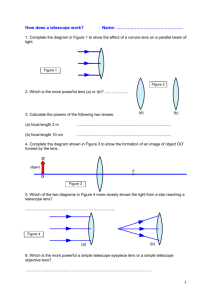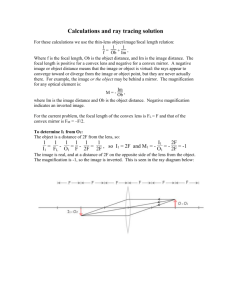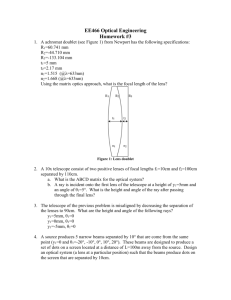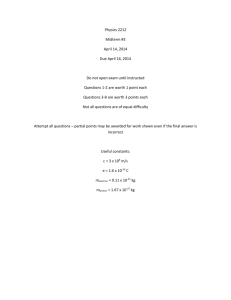Word - Sierra College Astronomy Home Page
advertisement
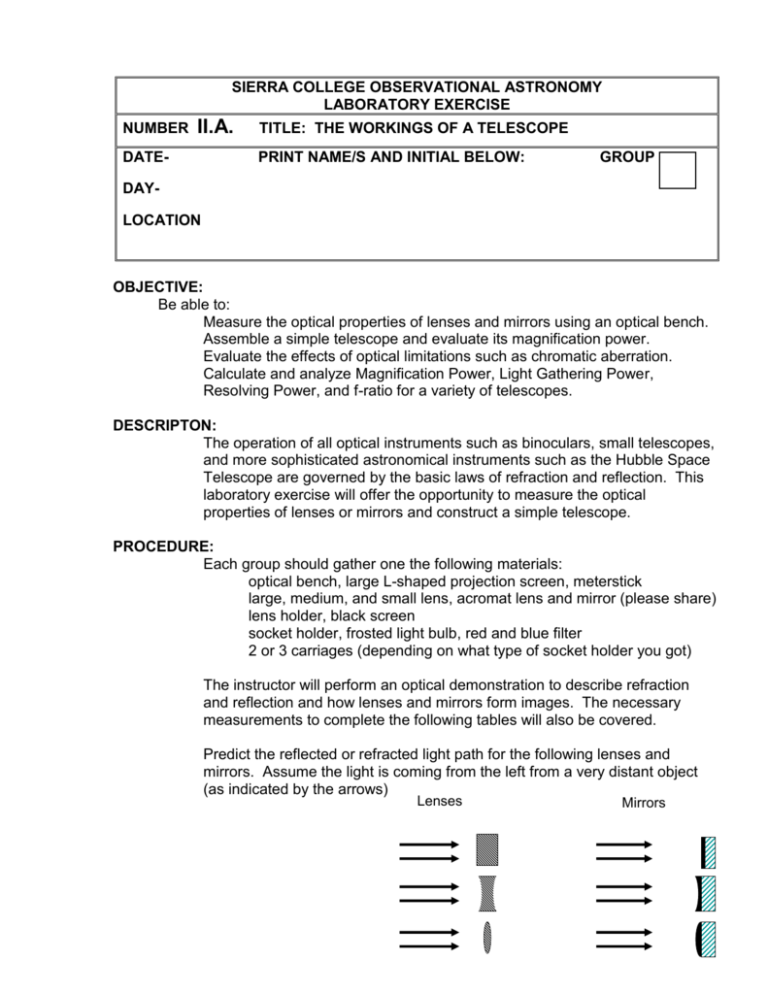
SIERRA COLLEGE OBSERVATIONAL ASTRONOMY LABORATORY EXERCISE NUMBER II.A. DATE- TITLE: THE WORKINGS OF A TELESCOPE PRINT NAME/S AND INITIAL BELOW: GROUP DAYLOCATION OBJECTIVE: Be able to: Measure the optical properties of lenses and mirrors using an optical bench. Assemble a simple telescope and evaluate its magnification power. Evaluate the effects of optical limitations such as chromatic aberration. Calculate and analyze Magnification Power, Light Gathering Power, Resolving Power, and f-ratio for a variety of telescopes. DESCRIPTON: The operation of all optical instruments such as binoculars, small telescopes, and more sophisticated astronomical instruments such as the Hubble Space Telescope are governed by the basic laws of refraction and reflection. This laboratory exercise will offer the opportunity to measure the optical properties of lenses or mirrors and construct a simple telescope. PROCEDURE: Each group should gather one the following materials: optical bench, large L-shaped projection screen, meterstick large, medium, and small lens, acromat lens and mirror (please share) lens holder, black screen socket holder, frosted light bulb, red and blue filter 2 or 3 carriages (depending on what type of socket holder you got) The instructor will perform an optical demonstration to describe refraction and reflection and how lenses and mirrors form images. The necessary measurements to complete the following tables will also be covered. Predict the reflected or refracted light path for the following lenses and mirrors. Assume the light is coming from the left from a very distant object (as indicated by the arrows). Lenses Mirrors DESCRIPTION OF LENSES OR MIRRORS FOR OPTICAL BENCH Lens/Mirror Achromatic A B C D E Brightest Chromatic Aberration Small Medium Large Mirror OPTICAL BENCH: Use the optical bench to determine the focal lengths (F) of the variety of lenses and mirrors provided. Use equation #1 to calculate ‘F’. Measure three different image distances (I) and object distances (O) for each lens. After calculating the focal length for each I,O pair, determine the average focal lengths for optics A thru E. For the mirror, focus an image next to the object arrow. The image distance will then equal the object distance. Three different people should make this measurement and then determine the average focal length for the mirror. Finally, measure the diameter (D) of the optics A thru E, and calculate the focal ratio (f/ratio) as determined by equation #4. TABLE A – OPTICAL BENCH RESULTS I O I+O F1 I O I+O F2 I O I+O F3 F avg. D A B C D E Eq. #1 1/F = 1/I + 1/O or IxO F = ----------I+O f/ DISTANT OBJECT METHOD TO DETERMINE FOCAL LENGTH: In equation #1, as O gets larger, 1/F gets closer in value to 1/I or the image distance approaches the value of the focal length (F = I). Focus the image of a DISTANT white light bulb for each lens. Measure the image distance (I) and record it in the table below as the focal length. Repeat this observation using a distant red and blue light. TABLE B – Focal Lengths (mm) Using Distant Objects/Different Colors Object FAR A B C D E White Light Blue Light Red Light BUILDING A TELESCOPE: Eq. #2 M = FO/Fe Magnification has no units. Select the achromatic lens as the objective (O) of the telescope. Select one of the other lenses to serve as the eyepiece (e). Compute the magnification power with equation #2 for each combination and record the results in table C. TABLE C – Telescope Magnifications Using Achromatic Objective Eyepiece Lens Computed M Estimated M (from eq. #2) (Compare the size of what you see in the telescope to that seen with your naked eye) Small Medium Large Measure the magnification power of each telescope combination by a method described by instructor. Enter these results in the above table for comparison with computed values. Also, in the table above, show the data and calculations to arrive at both computed and measured magnification. / LIGHT GATHERING POWER AND F RATIO (IMAGE BRIGHTNESS): The light gathering power (LGP) is a ‘unitless’ number indicating the relative amount of light or radiation a telescope objective can gather in contrast to a smaller (or larger) telescope objective. For example, by equation #3, a 10 inch telescope (telescope with 10 inch diameter objective) will gather 25 times more light than a 2-inch telescope. Eq. #3 L.G.P. = (D1/D2)2 The bigger objective or larger aperture, however, does not always produce the brighter image. The image brightness is dependent upon the objective diameter and focal length combined. The focal ratio (f/ratio) is determined by dividing the focal length of a lens or mirror by its diameter. Eq. #4 f/ratio = F/D It too, is a unitless number and useful for determining the length of exposure necessary for photographing an object. As mentioned before, measure the diameters of the optics in Table A and determine the f/ratios for each. Enter results in Table A. RESOLUTION: The ability of a lens or mirror to separate or distinguish two or more closely spaced points of light in an image plane is limited by diffraction. As a result, the smallest angular separation of two points that can potentially be resolved is given by = 2.1 x 105 x /D where is given in arc seconds, is the wavelength (color) of transmitted light from the object, and D is the aperture diameter. Any linear units can be used for and D as long as they are the same. If is chosen to be 550nm (middle of the visible spectrum) then the simplified formula (#5) may be applied. Eq. #5 = 116/D ‘D’ is in millimeters SUMMARY QUESTIONS: (Place answers in the ‘Blue Book’) 1. In table A, which lens/mirror (A – E): a. produced the brightest image? b. Which one had the greatest light gathering power (LGP)? c. Did the brightest image correspond to the lens/mirror with the largest or smallest f-ratio number? 2. Which lens exhibited the least amount of chromatic aberration (a.)? b. Did the mirror exhibit any evidence of chromatic aberration? c. Should it have? 3. For a Meade telescope equipped with a 6 mm eyepiece: a. Calculate ‘M’. b. Calculate L.G.P. compared with the human eye (D=5mm). c. Calculate ‘’. d. Calculate the f-ratio. 4. What would limit the resolving power of a larger ground based telescopes? 5. Would the above answer also limit light gathering and magnification power as well?

